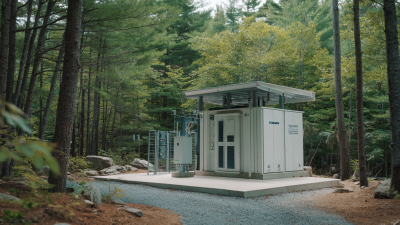
-
Home
-
About Us
-
Products
-
News
-
Blog
-
Contact Us
Leave Your Message

In an era where home safety is paramount, understanding the components that contribute to a secure living environment is essential. One such crucial element is the Electric Cut Out Fuse, a device designed to protect electrical circuits from overloads and short circuits. By automatically disconnecting the power supply in the event of an anomaly, this fundamental component plays a vital role in preventing potential hazards such as electrical fires and equipment damage. As households increasingly rely on electrical appliances and smart home technologies, the significance of maintaining a robust safety system that includes Electric Cut Out Fuses cannot be overstated.

In this article, we will delve into the top five reasons why Electric Cut Out Fuses are integral to effective home safety systems. From their ability to enhance safety to their role in supporting energy efficiency, we will explore how these devices function and the importance of having them installed in every home. Emphasizing the need for proactive safety measures, we aim to provide homeowners with insights on the importance of integrating Electric Cut Out Fuses into their residential electrical systems, ultimately fostering a safer living environment for families.
Electric cut out fuses play a crucial role in enhancing home safety by providing a reliable means of preventing electrical overloads and possible fire hazards. According to the National Fire Protection Association (NFPA), electrical failures are among the leading causes of home fires, accounting for approximately 20% of reported incidents. The presence of high-quality electric cut out fuses can break the circuit in case of overload, thereby significantly mitigating the risk of fires caused by electrical issues.
Moreover, a report by the Electrical Safety Foundation International (ESFI) indicates that homes equipped with proper electrical safety devices, including cut out fuses, experience a 50% lower risk of electrical fires compared to those without. By disconnecting power when excessive current is detected, these fuses protect not only your property but also your loved ones. Investing in modern fuse technology not only aligns with safety standards but also enhances overall energy efficiency, making them an indispensable component of any home safety system.
Electric cut out fuses are a crucial component of home safety systems, serving to protect electrical circuits from overloads and short circuits. There are several types of electric cut out fuses, each designed to meet specific needs and applications. One common type is the cartridge fuse, which is encased in a cylindrical shell and designed for high voltage applications. These fuses are convenient for replacing as they typically come in standardized sizes and can be easily removed and replaced when blown.
Another popular type is the plug fuse, often found in household settings. This fuse is inserted directly into a socket and can handle lower voltage levels, making it ideal for domestic applications. In addition to these, there are also resettable fuses, or polyfuses, which automatically reset after the overload condition is removed. This feature provides a significant advantage in terms of convenience and reduces the need for regular replacements, making them suitable for devices that may experience intermittent overloads. Understanding these various types of electric cut out fuses helps homeowners select the right protection for their electrical systems, ensuring safety and reliability.
Electric cut out fuses play a crucial role in safeguarding home electrical systems by preventing overloads and electrical fires. When an electrical fault occurs, such as a short circuit or excessive current draw, the fuse acts as a protective device that disconnects the power supply, thus averting potential hazards. According to the National Fire Protection Association (NFPA), approximately 23,000 home structure fires each year are attributed to electrical failures or malfunctions, underscoring the importance of having an effective fuse system in place.
The functioning of electric cut out fuses is straightforward yet vital. These fuses contain a conductive element that melts when the current exceeds its rated capacity, thereby interrupting the circuit. This mechanism is particularly important in residential settings where electrical appliances and systems may draw varying amounts of power. A study by the U.S. Consumer Product Safety Commission revealed that homes equipped with properly functioning fuses and circuit breakers significantly reduce the risk of electrical fires, as they can respond to dangerous conditions more rapidly. In summary, integrating high-quality electric cut out fuses not only enhances overall home safety but also ensures compliance with local electrical standards.
| Dimension | Description | Function | Importance |
|---|---|---|---|
| Type of Fuse | Electrical device designed to protect electrical circuits | Stops current flow when excessive current is detected | Prevents electrical fires and equipment damage |
| Rating | Measured in Amperes (A), indicating maximum current it can handle | Ensures fuse trips during overload conditions | Crucial for selecting appropriate fuses for home circuits |
| Location | Installed in electrical panels and specific circuit setups | Protects individual circuits from overloads and short circuits | Essential for localized protection within a home’s electrical system |
| Resettable vs. Non-resettable | Resettable fuses can be reused, while non-resettable must be replaced | Different maintenance and operational implications | Impact on overall safety and convenience of the electrical system |
| Maintenance | Regular checks for functionality and signs of wear | Ensures reliable performance during overload scenarios | Critical for long-term safety and prevention |
Electric cut out fuses play a crucial role in home safety systems by protecting electrical circuits from overloads and short circuits. Understanding the common issues associated with these fuses can help homeowners mitigate risks and maintain a safe living environment. One prevalent problem is a blown fuse, which can occur if too many devices are connected to a single circuit or due to a fault in an appliance. When this happens, the fuse will interrupt the flow of electricity, preventing potential fires or equipment damage.
Tips: To troubleshoot, start by inspecting your appliances and unplugging those that may contribute to overloaded circuits. If the fuse continues to blow despite reducing the load, it might be time to replace it with one that has a higher amperage, although this should only be done with caution and ideally, under the guidance of a professional.
Another common issue is the degradation of fuses over time, leading to inefficiency. Regular inspection and timely replacement of old or damaged fuses can significantly enhance electrical safety. If you notice signs of heat or burn marks around the fuse box, it's essential to address this immediately and consult an electrician to avoid further complications.
Electric cut out fuses play a critical role in ensuring the safety of home electrical systems. These devices are designed to protect circuits from overloads by breaking the connection when excessive current is detected. According to the National Fire Protection Association, electrical malfunctions are a leading cause of home fires, emphasizing the need for homeowners to maintain their electrical systems effectively. Regular inspection and timely replacement of cut out fuses can prevent malfunctions that might lead to hazardous situations, such as fires or electrical shocks.
Best practices for maintaining electric cut out fuses include checking for signs of wear, such as discoloration or corrosion, and ensuring that fuses are the appropriate type for the circuits they serve. Homeowners should also familiarize themselves with the specific amperage ratings of their fuses. The Electrical Safety Foundation International suggests that homeowners replace fuses that frequently blow, as this may indicate an underlying electrical issue that needs to be addressed by a qualified professional.
Furthermore, utilizing tools designed for safe fuse removal and installation can greatly enhance safety during the maintenance process, minimizing the risks associated with electrical repairs.





